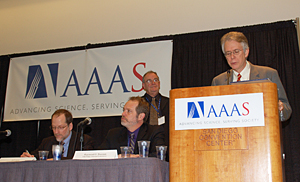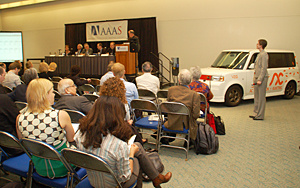

ADVERTISEMENT
- Rozovsky wins prestigious NSF Early Career Award
- UD students meet alumni, experience 'closing bell' at NYSE
- Newark Police seek assistance in identifying suspects in robbery
- Rivlin says bipartisan budget action, stronger budget rules key to reversing debt
- Stink bugs shouldn't pose problem until late summer
- Gao to honor Placido Domingo in Washington performance
- Adopt-A-Highway project keeps Lewes road clean
- WVUD's Radiothon fundraiser runs April 1-10
- W.D. Snodgrass Symposium to honor Pulitzer winner
- New guide helps cancer patients manage symptoms
- UD in the News, March 25, 2011
- For the Record, March 25, 2011
- Public opinion expert discusses world views of U.S. in Global Agenda series
- Congressional delegation, dean laud Center for Community Research and Service program
- Center for Political Communication sets symposium on politics, entertainment
- Students work to raise funds, awareness of domestic violence
- Equestrian team wins regional championship in Western riding
- Markell, Harker stress importance of agriculture to Delaware's economy
- Carol A. Ammon MBA Case Competition winners announced
- Prof presents blood-clotting studies at Gordon Research Conference
- Sexual Assault Awareness Month events, programs announced
- Stay connected with Sea Grant, CEOE e-newsletter
- A message to UD regarding the tragedy in Japan
- More News >>
- March 31-May 14: REP stages Neil Simon's 'The Good Doctor'
- April 2: Newark plans annual 'wine and dine'
- April 5: Expert perspective on U.S. health care
- April 5: Comedian Ace Guillen to visit Scrounge
- April 6, May 4: School of Nursing sponsors research lecture series
- April 6-May 4: Confucius Institute presents Chinese Film Series on Wednesdays
- April 6: IPCC's Pachauri to discuss sustainable development in DENIN Dialogue Series
- April 7: 'WVUDstock' radiothon concert announced
- April 8: English Language Institute presents 'Arts in Translation'
- April 9: Green and Healthy Living Expo planned at The Bob
- April 9: Center for Political Communication to host Onion editor
- April 10: Alumni Easter Egg-stravaganza planned
- April 11: CDS session to focus on visual assistive technologies
- April 12: T.J. Stiles to speak at UDLA annual dinner
- April 15, 16: Annual UD push lawnmower tune-up scheduled
- April 15, 16: Master Players series presents iMusic 4, China Magpie
- April 15, 16: Delaware Symphony, UD chorus to perform Mahler work
- April 18: Former NFL Coach Bill Cowher featured in UD Speaks
- April 21-24: Sesame Street Live brings Elmo and friends to The Bob
- April 30: Save the date for Ag Day 2011 at UD
- April 30: Symposium to consider 'Frontiers at the Chemistry-Biology Interface'
- April 30-May 1: Relay for Life set at Delaware Field House
- May 4: Delaware Membrane Protein Symposium announced
- May 5: Northwestern University's Leon Keer to deliver Kerr lecture
- May 7: Women's volleyball team to host second annual Spring Fling
- Through May 3: SPPA announces speakers for 10th annual lecture series
- Through May 4: Global Agenda sees U.S. through others' eyes; World Bank president to speak
- Through May 4: 'Research on Race, Ethnicity, Culture' topic of series
- Through May 9: Black American Studies announces lecture series
- Through May 11: 'Challenges in Jewish Culture' lecture series announced
- Through May 11: Area Studies research featured in speaker series
- Through June 5: 'Andy Warhol: Behind the Camera' on view in Old College Gallery
- Through July 15: 'Bodyscapes' on view at Mechanical Hall Gallery
- More What's Happening >>
- UD calendar >>
- Middle States evaluation team on campus April 5
- Phipps named HR Liaison of the Quarter
- Senior wins iPad for participating in assessment study
- April 19: Procurement Services schedules information sessions
- UD Bookstore announces spring break hours
- HealthyU Wellness Program encourages employees to 'Step into Spring'
- April 8-29: Faculty roundtable series considers student engagement
- GRE is changing; learn more at April 15 info session
- April 30: UD Evening with Blue Rocks set for employees
- Morris Library to be open 24/7 during final exams
- More Campus FYI >>
11:59 a.m., Feb. 23, 2010----The University of Delaware's vehicle-to-grid technology drove onto the world's stage at the annual meeting of the American Association for the Advancement of Science (AAAS) on Friday, Feb. 19, in San Diego, offering a mode of mobility that's “green” in more ways than one.
Non-polluting V2G cars would help the environment, reduce U.S. dependence on foreign oil, and also put potentially thousands of dollars a year back in their owner's pocket, according to Willett Kempton, professor in UD's College of Earth, Ocean, and Environment and director of UD's Center for Carbon-free Power Integration.
The first V2G patent was filed on behalf of UD by Kempton and Jasna Tomic, who earned her doctorate at UD and now works as new-fuels project manager for CALSTART, a nonprofit energy research center dedicated to high-tech, clean transportation technologies based in Pasadena, Calif.
Kempton's presentation was part of the AAAS session “Toward Green Mobility: Integrating Electric Drive Vehicles and Smart Grid Technology,” organized by the Alliance for Automotive Manufacturers and the U.S. Department of Energy.
The University of Delaware is operating the world's first vehicle-to-grid (V2G) system, which enables electric cars to provide an electricity balancing service to the power grid and get paid for it. The balancing service, called “frequency regulation,” keeps the entire electric grid stable by compensating for mismatches between power generated and power used.
Three UD electric cars are connected to the power grid when they are not being driven, generating $5 to $10 a day, according to Ken Huber, manager of new technology at PJM Interconnection and a co-presenter at the AAAS session. The company, which coordinates the movement of wholesale electricity in all or parts of 13 Mid-Atlantic states and the District of Columbia, pays UD, the vehicles' owner, for this service to the power grid.
Once the technology is commercialized, Kempton says an electric car owner would need to invest about $1,500 up front, at current prices, to have V2G controls added to an electric car. Of course, he notes, one first would have to buy an electric car capable of providing two-way power flow, which is still priced well above gasoline cars.
Once the electric car is V2G-equipped, he says a car owner could make $3,000 per year providing power-balancing service for the grid.
Reflecting on the success of the AAAS symposium, Kempton notes, “In 12 years, this has gone from a fringe idea and some equations, to a running system with widespread acceptance, thanks to a lot of work by about 20 faculty and students here at UD, plus our commercial partners in the electric and automotive industries.”
A major advantage of V2G technology for the environment, Kempton says, is that it will make possible much larger expansion of renewable energy sources.
“This is because it is a form of low-cost storage that can take in electricity when an abundance of solar or wind power is available and can release electricity when there is not enough -- all without burning any fossil fuel,” he says.
As noted in the AAAS session abstract, accelerated adoption of electric drive vehicles could greatly diminish U.S. dependence on foreign oil and reduce greenhouse gas emissions. President Obama has set a goal of 1 million plug-in hybrid electric vehicles in the national fleet by 2015.
A bill introduced in Congress in December 2009, H.R. 4399, would provide funding to the Department of Energy and the U.S. Postal Service to convert existing mail trucks and manufacture new ones to use the UD-developed V2G technology.
Earlier this year, the University of Delaware announced the first licensing of its V2G technology by AutoPort, Inc., a major vehicle processing and modification facility in New Castle, Del. The non-exclusive license is in the area of commercial fleet vehicles.
AutoPort is now partnering with AC Propulsion, which makes the electric-drive system, to make several vehicles for the state of Delaware fleet, and to convert vehicles for evaluation by the U.S. Postal Service and other fleet operators.
Founded in 1848, AAAS serves some 272 affiliated societies and academies of science and publishes the peer-reviewed journal Science.
The AAAS annual meeting is one of the world's largest interdisciplinary scientific events, with broad national and international media coverage. Kempton's talk was covered by The Financial Times, Science News, The Irish Times, msnbc.com, the French news agency Agence France-Presse, and many other media.
For more information on UD's V2G technology, visit this Web site.
Article by Tracey Bryant
Photos courtesy Karras Photography/AAAS


